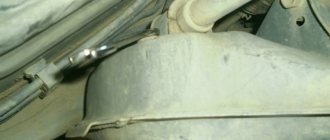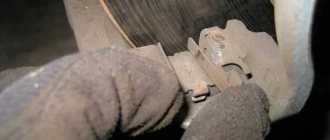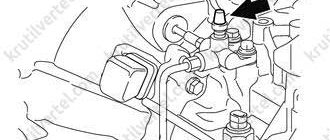When driving over bumps, extraneous sounds may be heard from the suspension. They are created by the anti-roll bar due to damage or excessive wear on its rubber bushings.
While the car is moving, the anti-roll bar constantly changes its position when the car rolls. The load falls on the bushings, their diameter increases, and the stabilizer begins to be held less tightly. As a result, a knock appears and the vehicle's stability decreases.
The appearance of extraneous sound from the wheel arches often indicates damage to the stabilizer link. Due to the depressurization of the rubber bands, moisture gets into the gaps formed and the corrosion process starts. Bushings and racks are not repairable, so the problem with their excessive wear can only be eliminated by replacing them with new products.
Features of stabilizer bushings
One of the first parts that begins to bother owners when driving over uneven surfaces is usually the anti-roll bar, or rather its rubber bushing.
If a knock is periodically heard in the front part, then it may be necessary to replace the Toyota Corolla 150 stabilizer bushings. The procedure can be performed without assistants and does not require special pullers. The reason for the need to replace Toyota Corolla stabilizer bushings is their wear. It occurs due to the fact that the anti-roll bar constantly changes its position due to the lateral roll of the car. At this moment, the rubber bushing takes on most of the load. Gradually its diameter increases, which causes knocking and does not contribute to the stability of the car when driving at speed.
Despite the fact that the place where the part is attached is structurally protected by a metal plate, moisture, reagents spilling onto the road in winter, fine sand get under the bushing and the process of corrosion of the stabilizer begins. Over time, the diameter of the part decreases. This means that the stabilizer in the standard bushing will not be held so tightly. Japanese engineers thought about this and made a cut in the bushing design, which is intended for a tighter fit of the part. It also facilitates more convenient installation (disassembly) of the part.
Rubber or polyurethane? Which bushings are better for Corolla (150 body)
Original and polyurethane bushings for Corolla
You need to clearly understand that Toyota employs quite qualified engineers.
At least we had no reason not to trust them. When the question arises of replacing stabilizer bushings on a Corolla 150 body, many try to replace rubber elements with polyurethane ones. The motivation is simple - they walk longer. And now pure mechanics.
Beautiful and durable.
But it’s better not to install them . The bushing serves to absorb vibrations and shocks from the lower arms and not transmit them further to the suspension elements, steering rack, and tie rods. If this element served as the fulcrum of the stub, it could easily be replaced with metal bushings or some kind of bearings and there would be no need to change anything. But cunning Japanese engineers installed a rather soft elastic element, which treacherously often wears out on our roads.
Of course, manufacturers of nylon and plastic oak stabilizer bushings have a much better understanding of which bushings need to be installed on a Toyota. That's why they sell eternal polyurethane elements. The material really lasts a long time. But what is the price of such a resource? At first glance, everything seems logical - a solid, dense bushing lasts longer. This is true. But one cannot ignore the following nuances:
- The hard material of the bushing transfers shock and vibration to the suspension and steering components, reducing their service life.
- A dense non-original bushing limits the mobility of the stabilizer, violating the design geometry of its operation.
- The steering rack life is reduced.
- The bushing should not press the stabilizer too tightly, so the technology for installing new bushings involves lubricating them.
Interesting on the topic: Replacing the front and rear bumpers on a Suzuki Grand Vitara
In short, yes. Whether to install fashionable polyurethane or cheap rubber bushings is, of course, an individual decision.
Toyota front suspension diagram with “improved performance” tires
The procedure for performing work on replacing bushings
To replace the bushings, set the car to the handbrake. There is no need to disconnect the negative terminal from the battery. Next, perform the following operations.
- Jack up the car on both sides so as to relieve the load on the front axle.
- Remove the plastic protection covering the chassis elements.
- Remove the metal plates that clamp the stabilizer bushing. When removing the bushing, rotate it so that it is convenient to remove it. Use a spatula to increase the gap. Before replacing the Toyota Corolla stabilizer bushings with new ones, lubricate the area with special silicone. The installation process will be faster, and the rubber will be covered with a water-repellent layer.
- When inserting a new bushing, pay attention to the hole in the metal casing into which the protrusion on the rubber product should fit.
- Reassemble in reverse order.
Signs of bushing failure
Typically, the bushing and stabilizer can last up to 30 thousand kilometers. However, mileage on domestic roads is reduced; it is recommended to replace these parts a little earlier than the established deadlines. One of the first signs of instability in their work will be.
- The sound of a “loose” steering rack.
- There is play in the steering wheel when turning Toyota Corolla.
- You can feel the characteristic beating of the Toyota Corolla steering wheel.
- The car drives and is unstable on the road.
- Vibration and noise appear in the Toyota Corolla suspension units.
- When driving on uneven roads at low speeds, dull sounds appear.
- The comfort of traveling in a Toyota Corolla car decreases.
This means that it is necessary to replace the struts and bushings according to the regulations. Although, as we said earlier, given the current quality of our roads, it is better to do this in advance. You can't ignore the first signs. All suspension elements are closely interconnected. Timely replacement of these parts will prevent premature wear of other suspension components of the Corolla car.
If the above symptoms are found, you need to make an appointment, undergo diagnostics, and repair the suspension of your Toyota car.
Stabilizer's pole
If the wear of the stabilizer bushings is significant, then the next element that may fail is the stabilizer link. Replacing the Toyota Corolla 120 stabilizer strut may be required after a mileage of more than 50 thousand km.
A part manufactured under license will last two or even three times less. In most cases, this is due to a loose fit of the rubber boot, as a result of which moisture gets under it and the corrosion process begins. You should pay attention to this fact when choosing a manufacturer.
If knocking noises come from under the wheel arches, this may indicate the need for work to replace the stabilizer struts. This item cannot be repaired. The operating procedure is as follows.
- Remove the front wheel.
- Jack up the lower arm.
- Turn the steering wheel in the desired direction for easy access to the part.
- Clean the connection from dirt and treat the threaded connection with BD-40.
- Break off the bolt, and then insert a socket wrench (hexagon and unscrew the nut holding the post. The upper connection is easier to unscrew. This is due to the fact that it is less susceptible to corrosion, since less moisture and dirt gets into it. If it is impossible to unscrew it in the usual way, then try preheat the connection or use pliers.
- Install a new one in place of the removed stand.
The procedure for replacing the Toyota Corolla 150 stabilizer bar is the same on both sides.
We assemble the tool and prepare for replacement
To prepare the car for replacement, it is washed from below. This will make working more comfortable. To replace it, it will be necessary to use an inspection hole or overpass. The jack doesn't work. The fact is that by lifting one side of the car, we change the load and geometry of the stabilizer, which will cause difficulties during installation and also does not guarantee that the bushing will be as it should be.
In addition to the standard tool, we will need a torque wrench to tighten the clamps after installing the bushings with a force of 87 Nm. If everything is at hand, you can start working.
Changing bushings with your own hands
- Installing the car on the inspection hole.
- If it is not possible to put the car in a pit, then you need to remove the front wheels, plastic protection and fender liners, and install the car with the hubs on stands on both sides. There is a stabilizer, under which there are bushings.
- After this, you need to remove the protective brackets by unscrewing the bolts on which they are attached.
- There are fixing clamps on the stabilizer bushings; they need to be removed.
- Now we have to work with the bushing itself. Without protection, the stabilizer bushing is immediately visible. Its wear is noticeable to the naked eye: cracks, deformations, uneven fit to the beam and stabilizer.
- The bushing can be easily removed by hand; no tools are needed.
- The area is washed from dust and dirt.
- We replace the worn part with a new one. The shape of the bushings for the left and right sides is different, please note that the new bushing must match the old one in shape. When installing a new part, lubricate them. Also, if the bushing does not fit into place, you can and should use vegetable oil or WD-40.
- Make sure that the protrusion on the bushing fits into the hole in the clamp.
- The bushing mounting bolts are tightened with a force of 87 Nm.
- You need to put the protection back together, maintaining order and tightening all the parts tightly.
- We replace the second bushing on the other side in the same way.
Interesting on the topic: Replacing the stabilizer strut for Ford Focus 2, rating of the best struts
There are fakes that not only do not meet quality requirements, but can also cause significant damage to the suspension and steering system of the car. Replacing the bushing manually does not require much effort or special skills. The price will not hit your pocket, all you need is an inspection hole or overpass and time.
The price for replacing a bushing at a service station is not too steep, but if you can do the work yourself, why not save on a new set of bushings? But ignoring such problems does not lead to anything good; the bushing must be changed when the first signs of wear appear and original bushings must be installed.
Article number and cost of original stabilizer struts for Toyota Corolla 120 and their analogues
Branded Corolla 120 racks have article number 4882032010. Their price ranges from 1600 to 2500 rubles. Analogs of original racks from manufacturers, which are presented in the table below, have become widely popular among car owners.
Table - The best alternatives to the original stabilizer struts for the Corolla120
| Company manufacturer | Article number | Approximate cost, ruble |
| AYD | 9601814 | 260-280 |
| Nipparts | J4962026 | 155-270 |
| Japan Parts | SI111 | 300-320 |
| Glober | 614767 | 290-400 |
| Blue Print | ADT38530 | 500-550 |
| Febi | 22993 | 520-570 |
| ABS | 260381 | 310-340 |
| TRW | JTS7552 | 590-635 |
In order to replace struts on a Corolla120, it is recommended to follow the instructions below.
- Raise the vehicle on a lift or jack up the front end. For greater reliability, it is recommended to place supports. You should also secure the car with the parking brake and place wheel chocks under the rear axle.
- Unscrew the wheel nuts. Remove the wheel.
- Remove the fender liner.
- Clean all dirt with a wire brush.
- Threaded connections are constantly exposed to aggressive external environments. Therefore, before unscrewing them, you should treat everything with a penetrating lubricant.











